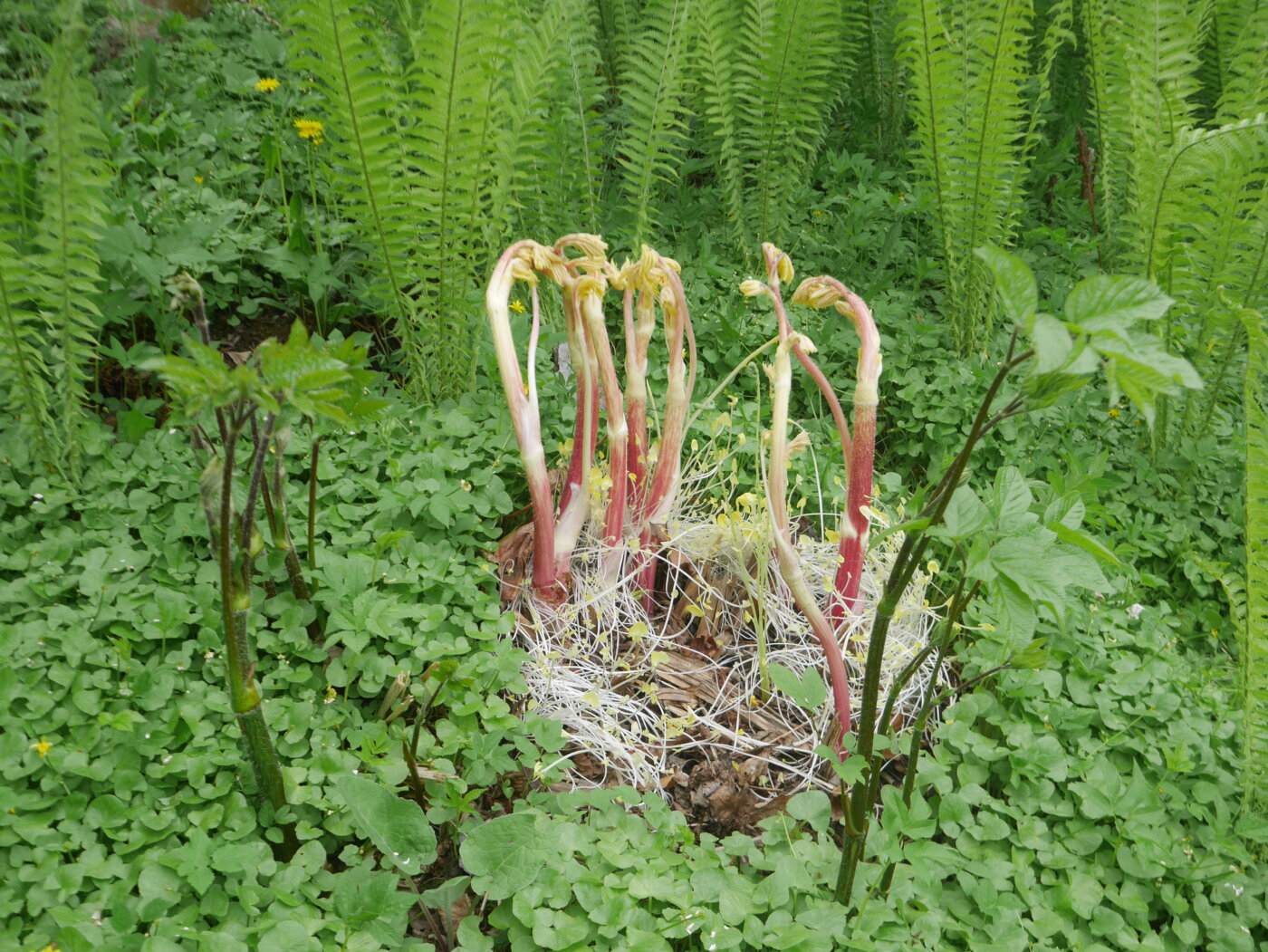Stephen Barstow´s book Around the World in 80 Plants came out in 2014 and immediately made a huge impact on my life. I had the bright idea that I would try to add 20 of the best of his 80 plants to my farm and slowly move towards making a business out of selling permaculture plants. The logic was that these were plants that anyone could enjoy and harvest once they were established, but not everyone had the knowledge or time to get from the seed to the established phase, and plants are not always available and often expensive. I figured this should be a simple problem to solve, and that I could do some ecological good in the process.

Stephen Barstow with mature Udo 
Blanched Udo sprouts 
Udo spring harvest
Stephen made a big impression on me when I visited his garden in November 2015. As he looked over the list of about 40 plants that I wanted cuttings or seeds from he turned to his Excel list of some 3000 varieties that he had grown in his garden and made some brief nots on a sheet of paper of the location of the plants. We then put our raincoats on and headed to the garden. I stood still holding a tray as Stephen quickly zipped off with his paper, returning seconds later with a cutting. This went on in what seemed to me to be one of those fast forward clips where a house is erected over a 24-hour period and we experience it in 2 minutes. Suddenly I had a tray of 40 perennial cuttings or roots, and a bunch of seeds to boot. I felt I too wanted to be connected to the soil and diversity like that. It seemed so vibrant, healthy and fun.
Around the World has since become one of my main references and I have slowly added more and more of the plants in it to my farm. One of the first plants I established was Udo (Aralia cordata) a Sansai plant (which in Japanese means mountain vegetable).
Udo is in the Ginseng family and is thus closely related to the number one Chinese and Korean traditional medicinal plant Panax ginseng. It is considered an adaptogen which David Winston in his book Adaptogens: herbs for Strength, Stamina and Stress Relief says “help the body adapt to stress, support normal metabolic functions, and help restore balance. They increase the body´s resistance to physical, biological, emotional, and environmental stressors and provide a defense response to acute or chronic stress […] in 1974, Dr. Nikolai Lazarev defined an adaptogen as an agent that allows the body to counter adverse physical, chemical, or biological stressors by raising nonspecific resistance towards such stress, allowing the organism to “adapt” to the stressful circumstances.” This lead me down a road to other adaptogens which I will return to in other blog posts.
As you can see in the pictures, Udo get huge! They can grow to 3 meters and die right back to the ground each year. You would be hard pressed to find a plant that produces that much biomass year after year. Stephen says its his most productive plant and I don’t doubt it. Traditionally you eat the blanched shoots in the spring. You simply place a bucket over the plant before it starts to sprout and cut the shoots down. His book gives several recepies for how to eat it and his blog Edimentals.com has blog posts from his visit to Japan where they force the plants in caves under Tokyo.
Udo takes 5 months of stratification (cold treatment) for the seeds to break dormancy. The sprouts dont show up before mid summer and are tiny. The plants stay small the first year, and it takes another three years before the plant starts to look like proper plants. By the 4th or 5th year (depending on local conditions) it starts to produce decent amounts of seed. I got about 50 plants to sprout in 2016 and established them all in the greenhouse. 2017 I started moving some of them out to the garden. Sadly in 2018 I moved 20 plants to the ravine and other locations, all of which died in the drought. Luckily I had sourced more seed and kept about 30 plants in the greenhouse. In 2019 the Udo started to take over the greenhouse, so I moved 20 more out in 2020. Those all made it through the season and I expect have all survived this relatively mild winter. I am now digging up the last 10 plants from the greenhouse (I may keep one there just for comparison and to ensure a good source of seed). I now have plenty of seed and sell Udo at stands on markets and Reko Rings.
In the book Eating Wild Japan Windfred Bird says that the King of Sansai is Udo´s close relative Taranoki (Aralia elata) which is more tree like and is also referred to as the Japanese Angelica Tree. I consider Udo the King due to the amount of growth it puts on each season and the size of the shoots. Also, because Stephen Barstow is in many ways the King of Sansai here in Norway and he has a special connection with this plant. Although, I have never tried Taranoki and expect I could change my mind if I ever tasted it.

